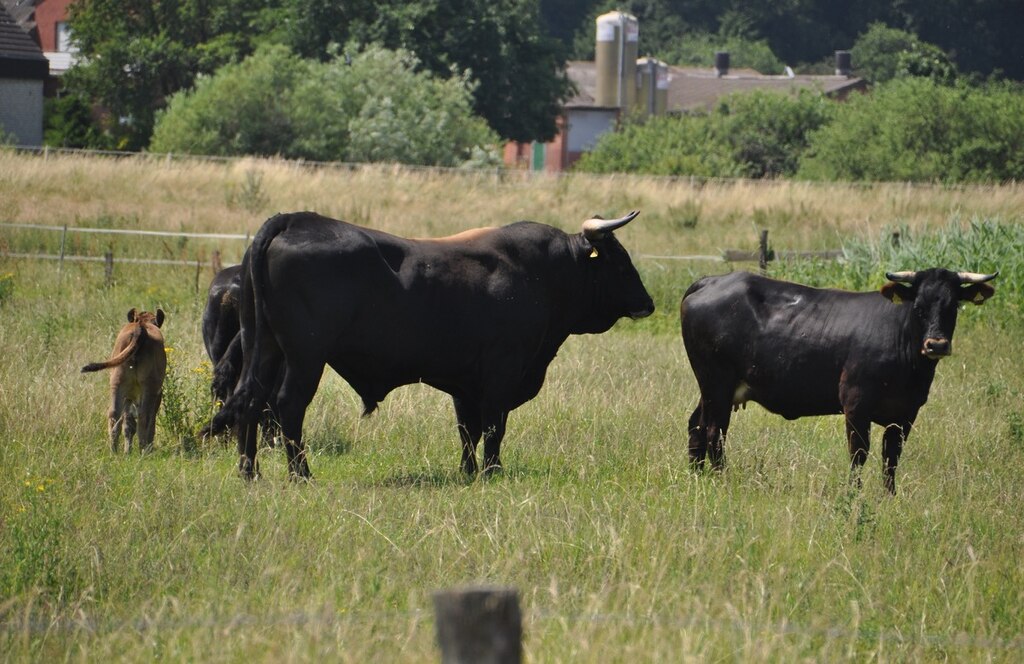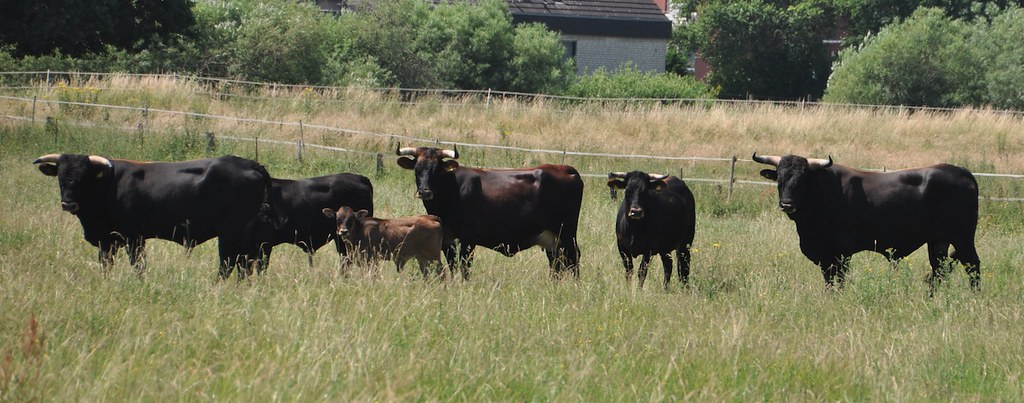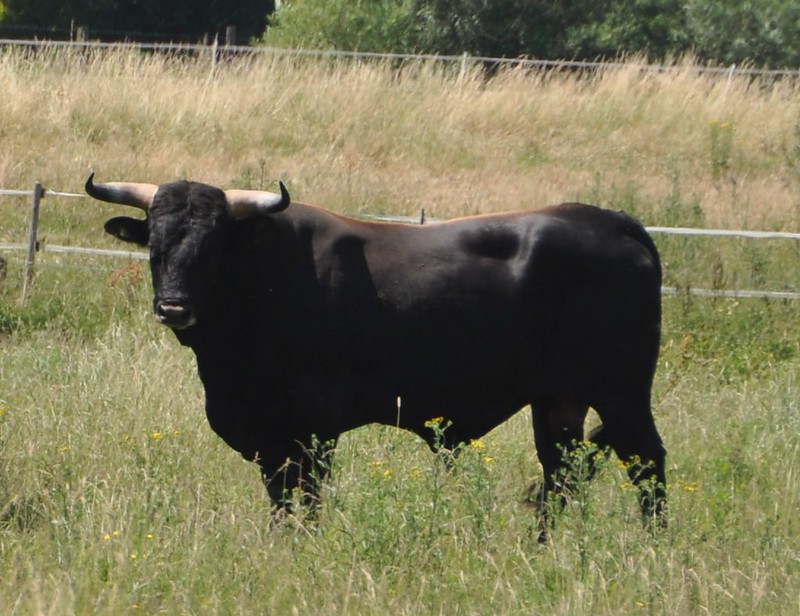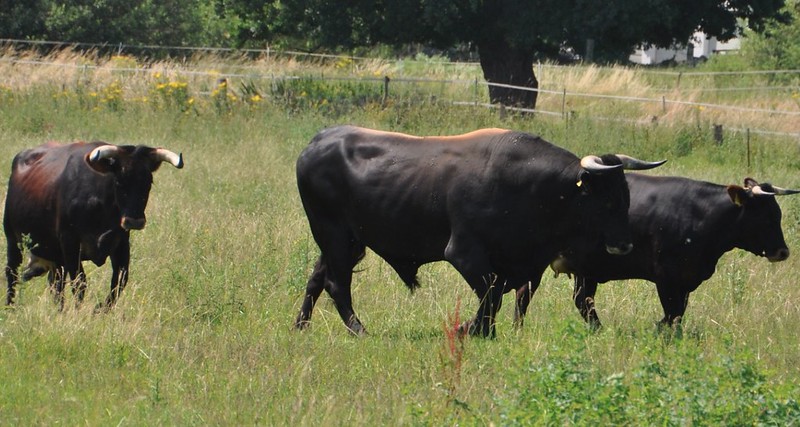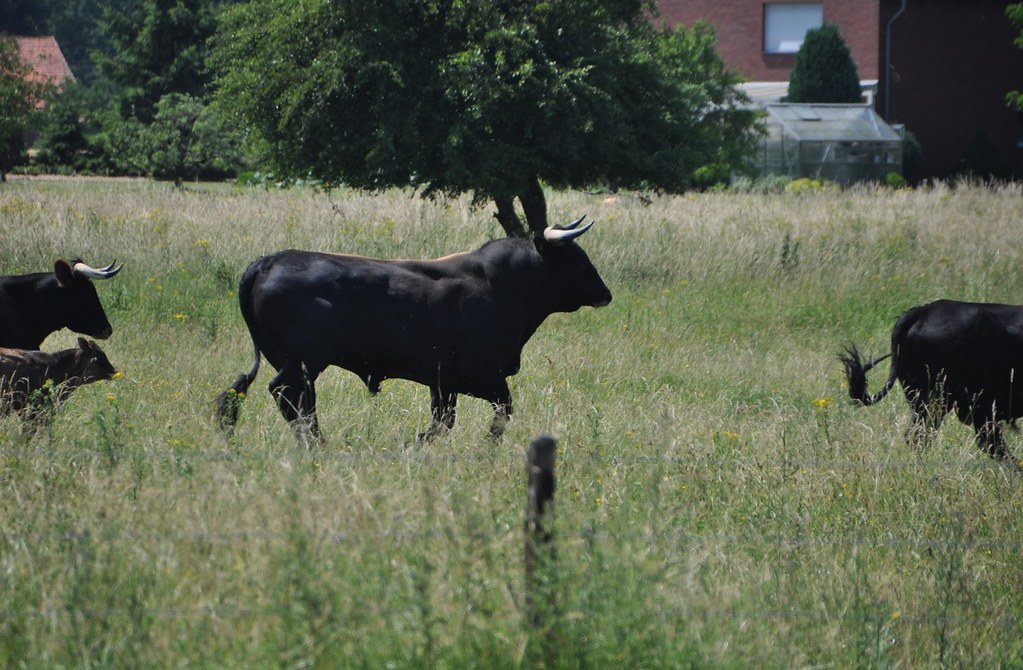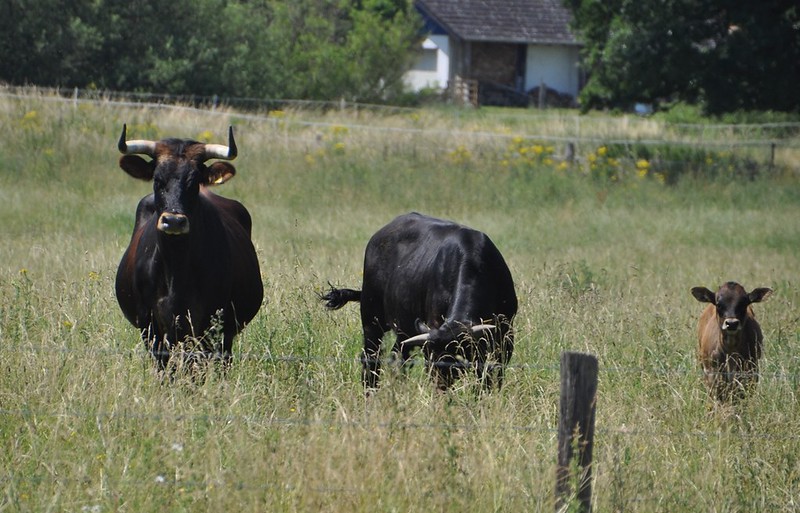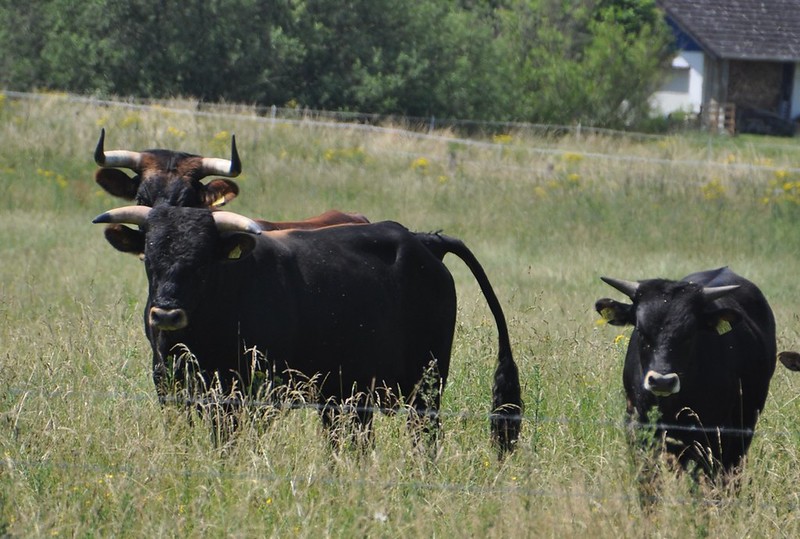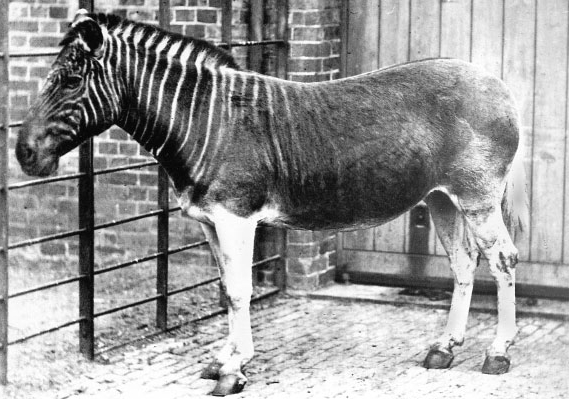The history
of Heck cattle mainly is a history of bad luck from a breeding-back point of
view – actually bad luck is not exactly the right word for it, because it is mainly
the result of people’s actions and not exclusively coincidences. This post is
not meant to attack these people, not at all, I just want to unemotionally
describe what I think went wrong in the creation of modern Heck cattle as an
aurochs look-alike and how it might have been made better.
The Heck
brothers’ project
The methodology
of the Heck brothers was reviewed by Cis van Vuure in his 2005 book (Retracing
the aurochs, Pensoft publishers, 2005) already (I don’t agree with him on every
aspect). However, I am going to list the main aspects of their project that went
wrong and resulted in Heck cattle becoming as we know it.
1. Sloppy
research on the aurochs
2.
Insufficient choice of breeds
3. Lack of
clear selection criteria and negligence of certain traits
4.The
crossbreeding and genealogy of their cattle were not documented
5. Wrong
assumptions on animal breeding
Except
number 2 (the possibilities to track down primitive cattle back this time were
much more difficult than today, especially when not knowing where to look for),
all those errors are consequences of choices and actions of the Heck brothers,
but this is not meant as critique. For some reason they used imprecise rock
carvings and paintings as model for the aurochs’ horns instead of the numerous
well-preserved skulls, they did not take care of the proportions, hump and
skull shape visible on complete skeletons, nor did they notice the different
body shape of domestic and wild cattle. The choice of breeds was insufficient because
it lacked certain aurochs features, such as body size (which was simply
neglected), horn size/shape, hump and skull shape. Would they have used
Chianina, Watussi and an useful Iberian breed (which were known to the Heck
brothers back this time) instead of all those derived breeds they included
(f.e. blackpied cattle), the outcome would have been much more aurochs-like
right from the beginning. And no, I am not neglecting hardiness here, because
all of these cattle are healthy landraces and therefore the outcome would have
been hardy anyway. The Heck’s choice of breeds also included a breeds that
added nothing but undesired traits, such as Angeln or Black-pied lowland cattle
(fat body, white spots, small horns). Remember that I am referring to those used
by Heinz Heck exclusively, because the lost Berlin lineage is not relevant for
modern Heck cattle. The Heck brothers neglected features such as body size,
partly because they thought that by simply crossing primitive breeds more
ancient features would emerge because of reuniting invisible traits, which
obviously was not the case and is not supported by modern genetics (again, the
Hecks are not necessarily to blame for that).
The Heck
brothers did not keep track of the crosses they executed, at least not
sufficiently and stopped totally during the 1930s. It would have been better if
they set up a breeding book right from the beginning, documenting which animal
descends from what other animal – in this case we would know the exact set of
breeds used and complete genealogy of all living Heck cattle today. A major mistake
was, apart from the sloppy research, not to set up a list of clear selection
criteria. Their selective breeding and that of the subsequent owners of Heck
cattle was and is only very vague and arbitrary. For example, they permitted
animals with a greyish tone in their coat and lyre-like horns, although there
is absolutely no hint that the aurochs possessed such traits. The degree of
variability in the aurochs (and basically all wild animals) was and is greatly
exaggerated, leading to the extremely heterogeneous breed we know today (I’m
not saying an aurochs look-alike has to be 100% homogeneous).
Post-war
Another
case of bad luck was that the Berlin lineage was lost during WWII, because Lutz
Heck used a slightly better set of breeds that was mainly based on Corsican,
Lidia and Camargue and they were also released in a number of wild paddocks.
The
surviving Heck cattle (~40 individuals) were spread among a number of German
zoos and soon increased in quantity. However, Reinhard Dathe, a former manager
of the Zoo at Eastern Berlin noted in 1980 that after the Second world war a
number of zoos removed their cattle, leading to a decrease of quantity and
quality of the stock (whatever he considered quality). What would have been
needed at this stage to prevent phenotypic chaos are the aforementioned clear
selection criteria, but also a coordinated breeding strategy that ensures that
the respective herds get selected for one goal and also exchange individuals to
achieve and maintain the desirable phenotype. But that didn’t happen, because
most zoos that kept Heck cattle did not intend to optically reconstruct the
aurochs or neither aware that these cattle aren’t yet, or simply thought they
look ancient enough and that they are for display exclusively anyway. Again,
this is not meant as critique. It is understandable that zoos did not care
greatly about Heck cattle, because it is obvious that a crossbreed of domestic
cattle cannot revive its wild type. Nevertheless, what happened was chaos;
population increase, genetic drift every time new herds were formed and only
loose selection resulted in herds that either showed more resemblance to one or
two founding breeds (f.e. got very Steppe cattle-like) or simply all possible
combinations of the features donated by the founding breeds, such as small and
extremely shortlegged and massive Hecks that look like short-haired Highlands
with aurochs colour, very short-or large-horned individuals, horn shapes of all
kinds, colours of all kinds, proportions of all kinds, absent to even very
prominent sexual dimorphism. Only few breeders, such as the Zoo Hellabrunn or
the Wildgehege Neandertal created herds with a wholly aurochs-like coat colour
and acceptable horns. The use of a Heck x Watussi cross cow in the Neandertal
was a very wise decision to achieve the latter trait.
What
could have been achieved
Considering
that Heck cattle has a bulk of non-aurochs-like features and but also a number
of unevenly distributed aurochs-like features in their gene pool, it is fun to
speculate what is the maximum degree of similarity of the aurochs that could
have been achieved with the breeds Heinz Heck worked with. So let’s assume Heck
cattle was bred carefully and coordinated, and always with the objective of creating
an accurate optic reconstruction of the aurochs since 1945 – without adding
other breeds, so no Watussi and no Taurus cattle. How much resemblance would be
possible with Heinz Heck’s cattle? Here’s a list of features that were present
in the original population:
- Aurochs-like
colour with well-marked sexual dichromatism (Corsicana, Murnau-Werdenfelser)
- More or
less large but not all too thick horns (Hungarian Steppe, Highland)
- Almost
accurate horn curvature and a shallow hump (Corsicana, partly Highland)
- Long legs,
withers height/trunk length ratio 1:1 (Steppe cattle)
- Small udder
(Steppe cattle)
- Body size
probably 150 cm in bulls and 140 cm in cows
The drawing
down below illustrates how I imagine a combination of these features with all
the undesired traits bred out might have had looked like:
The
difference between this, what Heck cattle should have been, and what most Heck
cattle today look like is quite amazing, isn’t it? And if you consider that
Taurus cattle and the large-horned Hecks descending from that half-Watussi cow add
large and thick and more forwards-facing horns, long snouts, long legs, larger
body size and a more athletic body with a hump, a complete optic aurochs that
also is hardy and healthy with a broad genetic basis is achievable.
It's finally getting better
When
grazing projects started, the number of Heck cattle herds increased significantly
once again. I guess that mostly the more primitive-looking Heck cattle were
chosen for these projects and often were and are bred for more aurochs-like
looks, but only casually as the primary target is landscape conservation. Not
to forget, there is also a number of private breeders that created some really
beautiful and aurochs-like herds, such as Walter Frisch. Some zoos and game
parks in which selective breeding with Heck cattle was not considered that
important seemingly served as islands for the survival of the particularly
“ugly” Heck cattle from decades ago (see f.e. the Zoo Neumünster or Wildpark
Frankfurt/Oder), some of them having a rather odd aspect (see here and here). But
interestingly, occasionally they possess features from their founding breeds
that the other, more derived lineages apparently lost. Modern Heck cattle in
general seemingly lost some features of their founding breeds, not only
undesired ones, such as the snout and horn shape of Corsican bulls when I look
at old photographs.
Cis van
Vuure concluded in his book that after 80 years of breeding Heck cattle, the
situation regarding an optic revival of the aurochs is probably as before; and
i.e. I agree with that statement. But the quality of Heck cattle as an aurochs
look-alike did not remain status quo since 1945. For example, the Wildgehege
Neandertal was one of the most important breeding locations for Heck cattle and
also executed effective selection in regards to coat colour and horns (and they
also were the first to document the pedigree of their cattle, thanks to that we
know that they used that half-Watussi cow). Because of their quality, cattle
from this herd were used by a lot of other herds what resulted in a certain
increase of authenticity of the breed as a whole. However, the resemblance to
the aurochs was and is still very meagre in the overwhelming majority of this
breed.
But in
recent years, the quality of Heck cattle on a number of regions increased
significantly. One reason might be that the interest in the aurochs and
breeding back grew as the value of robust cattle for conservation was
recognized and they were put out onto beautiful, natural pastures. While some
grazing projects consider the level of aurochs-likeness sufficient for their
purposes, others do select to a certain degree. But it was mainly the excellent
work of some private breeders like Walter Frisch who produced very valuable
animals (in this case great horns), and the creation of Taurus cattle (which
also emphasized the differences between usual Hecks and the aurochs) through
which the whole Heck population is getting more aurochs-like since the good
animals are increasingly popular among breeders because of their obviously more
authentic looks. Many southern-German herds have individuals with large horns
today, f.e. the one at the Nationalpark Bayerischer Wald or this Bavarian herd, but also grazing projects in the Spreeaue, Sachsen and others (The bull from Spreeaue in the link probably is a son of Walter Frisch's bull Ari, which covered or still covers this herd). The
emergence of Taurus cattle initiated by the ABU in 1997 was another crucial
step. Sayaguesa, Chianina and Lidia added size, long-leggedness,
forwards-facing horns and a more slender body that were lacking in the Heck
gene pool until then.
Mind that
Heck cattle per se is not a breeding-back attempt anymore, and all breeders are
free to breed their cattle how they want, so this process is progressing only
slowly.
It would be
really cool if a project that executes rigorous selective breeding with Heck
cattle would come into existence. Imagine someone would by 100+ Hecks (Taurus
included) from the best herds (f.e. Lippeaue, Wörth, Neandertal, Schmidtenhöhe,
Slikken van Flakee, and if legally possible OVP) and keeps them on a large,
semi-natural area. They would breed for them selves, the bulls fight for the
breeding rights, so that a certain degree of natural selection would be given,
but the undesired individuals would still be selected out. I think such a
project would produce really good animals and finally the full potential of
Heck cattle for aurochs “rebreeding” would be seized.

